MINOLTA RD-175 = AGFA ACTIONCAM
Delightful to use and not too expensive.
by John Henshall
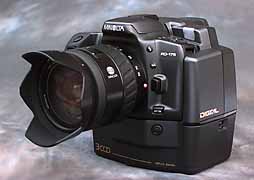
The Minolta RD-175 digital camera
Although the digital market is now being flooded
with low resolution cameras, the number of medium and high resolution cameras
being launched is still only a trickle. The Minolta RD-175, also known as
the Agfa ActionCam, is therefore a welcome addition to this small stream.
The only difference between the Minolta and Agfa versions is the name on
the camera and the opening screen of the software.
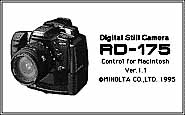
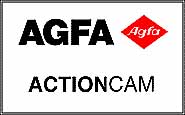
Most medium resolution digital cameras avoid re-inventing the wheel by
adapting existing SLR camera bodies, originally designed to use film. The
trick is to pack state-of-the-art technology into and around such bodies,
turning them digital while retaining their hand-held portability, independence
and ease of operation. In effect, such devices are highly sophisticated
portable computers with a lens. They use the very latest miniature technology
- right at the frontier of possibility - so it's hardly surprising that
high prices are involved. The RD-175/ActionCam uses the established Minolta
Dynax 500Si body.
There is no doubt that high prices have been restricting general market
acceptance, except for special applications. It is difficult to get prices
down if the camera uses a proprietary CCD chip, for such chips cannot be
used in other products, to recover development costs. They are produced
in small quantities, which also keeps costs high.
Low resolution digital cameras, on the other hand, use video camcorder CCDs.
These are already produced in large quantities and development costs have
been recovered elsewhere. This reduces CCD prices to the point at which
digital cameras can be made for a few hundred pounds.
Unfortunately, such inexpensive CCDs cannot produce even a 10 by 8 enlargement
and many low resolution cameras make matters even worse by using excessive
compression. Good 640x480 pixel images are suitable for reproduction up
to about 5.5x4cm at 300 pixels per inch in a high quality journal (200 line
screen). You might get away with a little larger but not much - unless,
like Minolta, you have a real brain-wave backed up with real technological
skills.
Instead of one CCD, Minolta use three in their new camera. Not red, green
and blue, as in professional video cameras, but two green and one striped
(with microscopic filter elements) red and blue. A dichroic prism block
splits the image-making light into the required components for each sensor.
Why two green CCDs? The human eye's sensitivity and resolving power is greater
in the green region of the spectrum than in the red and blue. Two green
chips make the camera almost twice as sensitive, with an EI equivalent to
film of ISO800. But the really clever part is that Minolta quadruple the
CCD's basic resolution by offsetting the two green chips physically, by
a distance equivalent to the size of half a pixel, in both the horizontal
and vertical planes. The two slightly different green signals produced by
this spatial offset are used to interpolate a green channel with a resolution
four times that of an individual CCD. Importantly, this means that Minolta
can use CCDs designed for video cameras - low cost, low resolution - to
achieve much higher apparent resolution than they possess individually.
Full marks to Minolta's Takatsuki Laboratory scientists for this imaginative
solution.
A disadvantage of using video CCDs is their small physical size when compared
with a frame of 35mm film. The half-inch video chips Minolta use have 768x494
pixels and an imaging area of 6.4x4.8mm - you could pack 25 of them into
the area of a piece of 35mm film. Relay optics are used to 'shrink down'
the image size produced by Minolta's normal 35mm SLR lenses to 16x12mm.
This means that the focal length of lenses used on RD-175 are effectively
doubled and the widest effective aperture reduced to f6.7. But the small
size of the CCDs turns to an advantage when it comes to cramming a complete
prism block and relay lens inside a SLR camera body.
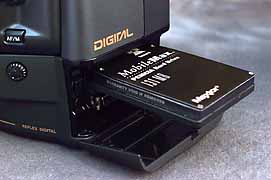
The PC Card slots neatly into the base of the camera
Images are transferred in raw form to a PCMCIA (PC card) Hard Disc Drive
inside the camera. This takes just over two seconds per image, during which
time no further exposure can be made. A raw image is about 1.2MB, so a 131MB
drive can hold 114 exposures. Basic exposure details (f-stop, shutter speed
and date) are recorded with each image.
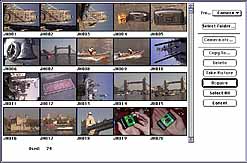 The camera is connected to a computer (Macintosh only at the moment) via a SCSI-2 interface which has yet another type of connector,
so take good care of the supplied cable. Acquire software is supplied both
as an Adobe Photoshop plug-in and as a stand-alone utility. Unfortunately,
the software is very basic when compared with acquire modules from other
manufacturers. The thumb-nail images cannot be increased in size; the image
sharpening is fixed and it is only possible to download one image at a time.
This is a major waste of your valuable time. It takes almost two hours of
constant attention to acquire and save all 114 images from the camera's
PC Card to a PowerMac (fifty seconds each on an 8100) or even longer on
an older Mac. It took one minute forty eight seconds per image on a Quadra
950 - over four hours to acquire and save a full PC Card. The lengthy acquire
times are because the images are interpolated, converted from the rectangular
pixels of the NTSC chips to square pixels and have other image processing
applied in your computer during acquisition. Finished images are 1528x1146
pixels - just over 5MB each. The camera is an eight-bit-per-channel device,
though thanks to superb A-to-D conversion within the camera this is not
evident in the images.
The camera is connected to a computer (Macintosh only at the moment) via a SCSI-2 interface which has yet another type of connector,
so take good care of the supplied cable. Acquire software is supplied both
as an Adobe Photoshop plug-in and as a stand-alone utility. Unfortunately,
the software is very basic when compared with acquire modules from other
manufacturers. The thumb-nail images cannot be increased in size; the image
sharpening is fixed and it is only possible to download one image at a time.
This is a major waste of your valuable time. It takes almost two hours of
constant attention to acquire and save all 114 images from the camera's
PC Card to a PowerMac (fifty seconds each on an 8100) or even longer on
an older Mac. It took one minute forty eight seconds per image on a Quadra
950 - over four hours to acquire and save a full PC Card. The lengthy acquire
times are because the images are interpolated, converted from the rectangular
pixels of the NTSC chips to square pixels and have other image processing
applied in your computer during acquisition. Finished images are 1528x1146
pixels - just over 5MB each. The camera is an eight-bit-per-channel device,
though thanks to superb A-to-D conversion within the camera this is not
evident in the images.
The basic nature of the software lets down a great hardware product. Fortunately,
software upgrades are easy to distribute via the Internet. Minolta should
get the Agfa software experts in Mortsel, Belgium, to re-write the acquire
module for them as a matter of urgency.
When you first pick up the camera, impressions are very positive. The camera
is well balanced with a low centre of gravity. Anyone who has had experience
of handling digital SLRs would find this camera very compact and, at 900
grams without lens, light in weight.


The best way to describe picture quality is by showing it. All the accompanying
pictures - except the product shots and masthead - were taken with the RD-175.
(The product shots (of the RD-175 camera) were taken with a Kodak DCS200.)

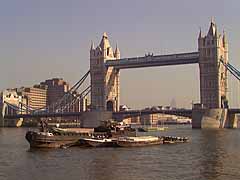
One important criticism is the inability to alter the ISO equivalence
from 800, except by using exposure compensation. A neutral density filter
is some help, but it is annoying to have to work with the resultant dark
viewfinder image. A variant with more buffer memory, to enable a burst of
images to be taken, would be a big advantage. Without this, the camera is
useless for photojournalism - one of the main potential uses of this kind
of camera. You can't capture much of the "Action" with a "Cam"era which has a two second delay between shots.
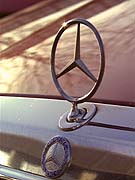
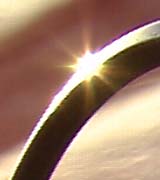
Enlarged to three times the theoretical maximum, this section
shows how well the RD-175/ActionCam handles specular highlights. The electronic
edge around the badge is added during image acquisition from the camera.
It would be nice if this feature could be turned off as sharpening for repro
should be a once-only process.
 The price has not been established by Minolta UK (contact Wayne Snell +44 (0)1908 200400). Agfa (contact Paresh Patel
+44 (0)181 231 4141) have a list price of £8,500 but expect a street
price of around £7,500 - or less. Bear in mind that this price is a
"system" price which includes the 24-85mm AF zoom, 131MB PC Card,
Lithium Ion battery (a standard camcorder battery - spares widely available),
charger and the acquire software. Many of these items are extras from other
manufacturers of products in this class, so compare prices very carefully.
The price has not been established by Minolta UK (contact Wayne Snell +44 (0)1908 200400). Agfa (contact Paresh Patel
+44 (0)181 231 4141) have a list price of £8,500 but expect a street
price of around £7,500 - or less. Bear in mind that this price is a
"system" price which includes the 24-85mm AF zoom, 131MB PC Card,
Lithium Ion battery (a standard camcorder battery - spares widely available),
charger and the acquire software. Many of these items are extras from other
manufacturers of products in this class, so compare prices very carefully.
If you want tomorrow's technology today, you have to pay for it. This Minolta/Agfa
offering is a delight to use and considerably cheaper than the present competition.
But the market will really open up only when someone produces a digital
SLR which is much cheaper still. Sell 'em cheap and you'll sell 'em fast - to everyone.
This review first appeared as "John Henshall's
Chip Shop" in "The Photographer" magazine, May 1996.
IMPORTANT NOTICE
This document is Copyright © 1996 John Henshall. All rights reserved.
This material may only be downloaded for personal non-commercial use. Please
safeguard the future of online publishing by respecting this copyright and
the rights of all other authors of material on the Internet.







 The camera is connected to a computer (Macintosh only at the moment) via a SCSI-2 interface which has yet another type of connector,
so take good care of the supplied cable. Acquire software is supplied both
as an Adobe Photoshop plug-in and as a stand-alone utility. Unfortunately,
the software is very basic when compared with acquire modules from other
manufacturers. The thumb-nail images cannot be increased in size; the image
sharpening is fixed and it is only possible to download one image at a time.
This is a major waste of your valuable time. It takes almost two hours of
constant attention to acquire and save all 114 images from the camera's
PC Card to a PowerMac (fifty seconds each on an 8100) or even longer on
an older Mac. It took one minute forty eight seconds per image on a Quadra
950 - over four hours to acquire and save a full PC Card. The lengthy acquire
times are because the images are interpolated, converted from the rectangular
pixels of the NTSC chips to square pixels and have other image processing
applied in your computer during acquisition. Finished images are 1528x1146
pixels - just over 5MB each. The camera is an eight-bit-per-channel device,
though thanks to superb A-to-D conversion within the camera this is not
evident in the images.
The camera is connected to a computer (Macintosh only at the moment) via a SCSI-2 interface which has yet another type of connector,
so take good care of the supplied cable. Acquire software is supplied both
as an Adobe Photoshop plug-in and as a stand-alone utility. Unfortunately,
the software is very basic when compared with acquire modules from other
manufacturers. The thumb-nail images cannot be increased in size; the image
sharpening is fixed and it is only possible to download one image at a time.
This is a major waste of your valuable time. It takes almost two hours of
constant attention to acquire and save all 114 images from the camera's
PC Card to a PowerMac (fifty seconds each on an 8100) or even longer on
an older Mac. It took one minute forty eight seconds per image on a Quadra
950 - over four hours to acquire and save a full PC Card. The lengthy acquire
times are because the images are interpolated, converted from the rectangular
pixels of the NTSC chips to square pixels and have other image processing
applied in your computer during acquisition. Finished images are 1528x1146
pixels - just over 5MB each. The camera is an eight-bit-per-channel device,
though thanks to superb A-to-D conversion within the camera this is not
evident in the images.





 The price has not been established by Minolta UK (contact Wayne Snell +44 (0)1908 200400). Agfa (contact Paresh Patel
+44 (0)181 231 4141) have a list price of £8,500 but expect a street
price of around £7,500 - or less. Bear in mind that this price is a
"system" price which includes the 24-85mm AF zoom, 131MB PC Card,
Lithium Ion battery (a standard camcorder battery - spares widely available),
charger and the acquire software. Many of these items are extras from other
manufacturers of products in this class, so compare prices very carefully.
The price has not been established by Minolta UK (contact Wayne Snell +44 (0)1908 200400). Agfa (contact Paresh Patel
+44 (0)181 231 4141) have a list price of £8,500 but expect a street
price of around £7,500 - or less. Bear in mind that this price is a
"system" price which includes the 24-85mm AF zoom, 131MB PC Card,
Lithium Ion battery (a standard camcorder battery - spares widely available),
charger and the acquire software. Many of these items are extras from other
manufacturers of products in this class, so compare prices very carefully.